Read this article today
https://www.kitplanes.com/length-ma...anes+Weekly&utm_campaign=KP-Weekly-2023-09-19
discussing selecting the correct length for screws, specifically re. grip length.
interesting report I think, but a little alarming as well. I'm no aircraft design expert, and it has been many years since I was heavily involved with machine design and the use and troubleshooting of threaded fasteners, but I do have quite a bit of experience in industrial settings.
...so I'm curious to know from you what I might be missing here.
The author prefaced by saying that most fasteners in an aircraft are in shear....but in my opinion didn't stress that condition as a foundation for his premise nearly enough...and all but I think one of the figures shows different applications that don't support the premise
The point he makes does make a little sense if you are looking at the screw as if it's working like a simple loose shear pin... and perhaps there are many fasteners in a typical aircraft that are designed in such a way.... but for the most part this is not the case. A properly tightened screw or bolt joint is putting the screw into tension, that puts a clamping force on the parts. Several of the photos used shows this sort of arrangement...basically the screws are clamping the two parts together...and the shear load would be taken up by friction between the two parts.
Even at maximum load, the sides of the holes should never really be in contact with the screw's shank, in a properly designed joint. If such a joint ever gets to the point where the screw is taking the shear load, the joint has already at that point basically failed.
Instead, a threaded fastener should be selected to maximize the number of threads inside the grip length (or working zone) of the screw. This because most of the work is done by that portion.... (the smallest diameter and therefore the most "springy" part of it.) Especially in applications with high temperature swings, or higher impact loading, installing only one or two threads inside the working length puts a tremendous loading onto those few threads. I've seen quite a few failures from that sort of thing....
https://www.kitplanes.com/length-ma...anes+Weekly&utm_campaign=KP-Weekly-2023-09-19
discussing selecting the correct length for screws, specifically re. grip length.
interesting report I think, but a little alarming as well. I'm no aircraft design expert, and it has been many years since I was heavily involved with machine design and the use and troubleshooting of threaded fasteners, but I do have quite a bit of experience in industrial settings.
...so I'm curious to know from you what I might be missing here.
The author prefaced by saying that most fasteners in an aircraft are in shear....but in my opinion didn't stress that condition as a foundation for his premise nearly enough...and all but I think one of the figures shows different applications that don't support the premise
The point he makes does make a little sense if you are looking at the screw as if it's working like a simple loose shear pin... and perhaps there are many fasteners in a typical aircraft that are designed in such a way.... but for the most part this is not the case. A properly tightened screw or bolt joint is putting the screw into tension, that puts a clamping force on the parts. Several of the photos used shows this sort of arrangement...basically the screws are clamping the two parts together...and the shear load would be taken up by friction between the two parts.
Even at maximum load, the sides of the holes should never really be in contact with the screw's shank, in a properly designed joint. If such a joint ever gets to the point where the screw is taking the shear load, the joint has already at that point basically failed.
Instead, a threaded fastener should be selected to maximize the number of threads inside the grip length (or working zone) of the screw. This because most of the work is done by that portion.... (the smallest diameter and therefore the most "springy" part of it.) Especially in applications with high temperature swings, or higher impact loading, installing only one or two threads inside the working length puts a tremendous loading onto those few threads. I've seen quite a few failures from that sort of thing....






